How Can Researchers Avoid Plagiarism While Ensuring the Originality of Their Manuscript?

This guest post is drafted by an expert from iThenticate, a plagiarism checker trusted by the world’s top researchers, publishers, and scholars.
Most of us understand the issues of plagiarism as well as the importance to take utmost care when citing all our sources in a research publication. However, it may surprise you to know how frequently researchers have had their papers rejected or retracted due to plagiarizing their sources unknowingly. This does not only involve the obvious copy and pasting of text that leads to plagiarism but also covers more subtle issues like improper paraphrasing, citation formats, originality checking, or even work done by your co-authors leading eventually to manuscript rejection. Hence, it is important that researchers today use a plagiarism checker, both during writing and before submission when publishing research manuscripts.
Take for example the case of an Assistant Professor at Brown University who had published a book in 2012 that took her years to complete. Although the ideas in the book were all her own, she had inadvertently plagiarized the work of other researchers due to unorganized note taking. Not only did she have to retract the work, but she also lost her job at the university, tarnishing her career.
If she had just taken the time to scan her book with a plagiarism checker, this could have easily been avoided. Unfortunately, her story is not unique; some journals are currently rejecting as much as 23% submissions after running them through a plagiarism checker. These programs not only check for exact phrase matches, but also for the less obvious forms of plagiarism that are sometimes unintentional.
Understanding Plagiarism
The publication process becomes more competitive each year and editors have more tools to identify research misconduct such as plagiarism. If your work contains any misconduct at all, it is grounds for rejection, so you need to know how to avoid plagiarism in research papers.
Plagiarism can take many forms, including:
- Duplication where a researcher reuses his or her own work from an earlier paper or study, without proper attribution (known as self-plagiarism);
- Improper citing where a researcher uses a secondary source, but only cites the primary sources contained in that secondary source;
- Paraphrasing when a researcher uses another person’s words and also adds in some original words of their own, but does not give proper attribution for the use of the original author’s words;
- Repetition of research where a person publishes a new study, but repeats data or text that has already been published in a similar study, and fails to give proper attribution for the original study; and
- Blatant, deliberate plagiarism where a researcher copies another researcher’s work without attribution or even submits another researcher’s manuscript under his/her own name.
These forms of plagiarism are quite common and all will result in rejected manuscripts even if the research findings are sound.
How to Write a Research Paper without Plagiarism
Learning how to properly cite your work is integral to becoming a published researcher. Proper citations give credit to the originators of the ideas and to the researchers who invested their time in developing the field. They also give your work more credence by tracing the evolution of the ideas and giving support for your claims. Citing sources is in your interest not only to avoid plagiarism but also to make your work widely trusted and accepted. Therefore, it’s important to occasionally remind yourself of when citations are necessary.
The most frequent types of citations are for concepts, ideas, and findings that are not your own. This is the easiest type of citation that informs the reader about who developed those findings, and where to read more about them.
The second type of citation is used anytime you quote or paraphrase another author or written work. It is important to understand that even if you change the language and wordings, if it is not an idea you came up with on your own, then it needs to be attributed. It also matters whether or not it is in quotation marks. If it is an exact quote, it should always be in quotations, otherwise, this could be considered plagiarism. Essentially, anytime you convey information that is not your own direct findings, or what is considered public knowledge for the field, there needs to be a reference to the source.
When writing short pieces, it is easier to avoid plagiarizing by ensuring that you never directly copy text and properly convey the findings of other authors in your own words or put them in quotes. By being organized, you can ensure that you cite the sources to their true origins and include all the necessary reference information in your “works cited” section. However, this becomes much harder when you start writing longer pieces and become more knowledgeable in your field of study. Sometimes, what may seem like your own words or common knowledge are in fact not. That is why it is so important to use a plagiarism checker.
How to Use an Online Plagiarism Checker
In a recent poll of journal editors by the Committee on Public Ethics (COPE), 58% noted that the biggest ethical challenge was detecting “plagiarism and poor attribution standards.” As plagiarism detection software becomes more advanced and easier to use, you can be assured that publishers are using it to check your work, and so should you.
A researcher who needs to have a paper checked for plagiarism sends the manuscript to Enago, selecting iThenticate. With its flexibility, iThenticate accepts a number of file formats, including Microsoft Word, Microsoft Excel, PDF, Latex, and others. The researcher receives a clear, easy-to-read report that highlights any potential areas of plagiarism, along with links back to the original content.
The entire process is simple, easy, and effective. Furthermore, those using Enago proofreading and editing services will already have access to the iThenticate integration.
Does Similarity Always Indicate Plagiarism?
One of the iThenticate plagiarism checker’s important features is its exclusion option because not every similarity in a manuscript is necessarily harmful. However, researchers can waste valuable time working their way through too many unnecessary matches, as they check their manuscript for potential plagiarism. With iThenticate’s exclusion options, you can narrow down to the most critical matches. You receive more focused, accurate reports and can save time in the review process because those unnecessary matches are excluded from the start.
The exclusion option allows you to exclude quoted material or bibliographic material that does not need to be checked. It also allows researchers to exclude small matches below a certain word count. If you want to exclude certain sections, such as an abstract or a methods and materials section, it is as simple as checking a box next to the section you want to exclude.

Once the manuscript has been scanned, if you determine that a match is not needed, you can exclude that source from the report. At that point, the report will be recalculated, with that source removed from the matches. The report still contains a list of all excluded sources. If you decide at any point in your review process that an excluded source does need to be re-included, that can be done simply with a checked box.
Takeaway
By using a trusted plagiarism checker like iThenticate before the manuscript reaches the publisher’s inbox, researchers can boost their chances of publication and grow their career wisely. These originality checkers can verify the authenticity of your manuscript, help detect and remove plagiarism, thereby making it more credible.
If you would like to know how you can use the iThenticate Plagiarism Check for your manuscript, you can contact the Enago team. You can also check out our previous article in this series on plagiarism with iThenticate.










Thank you for nice information.